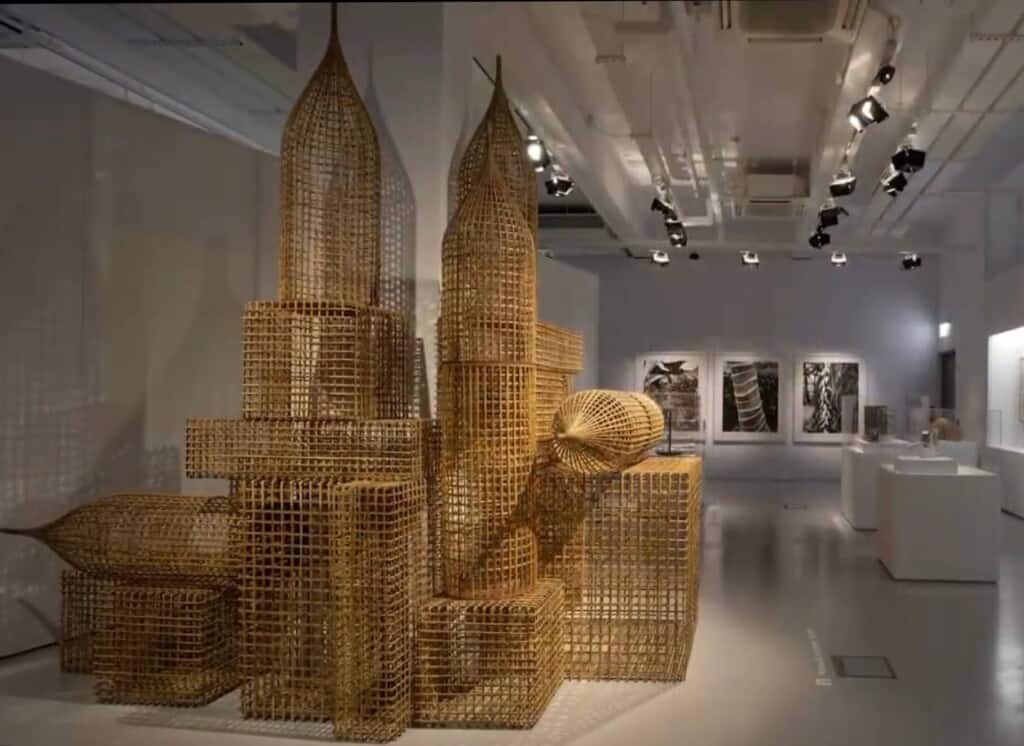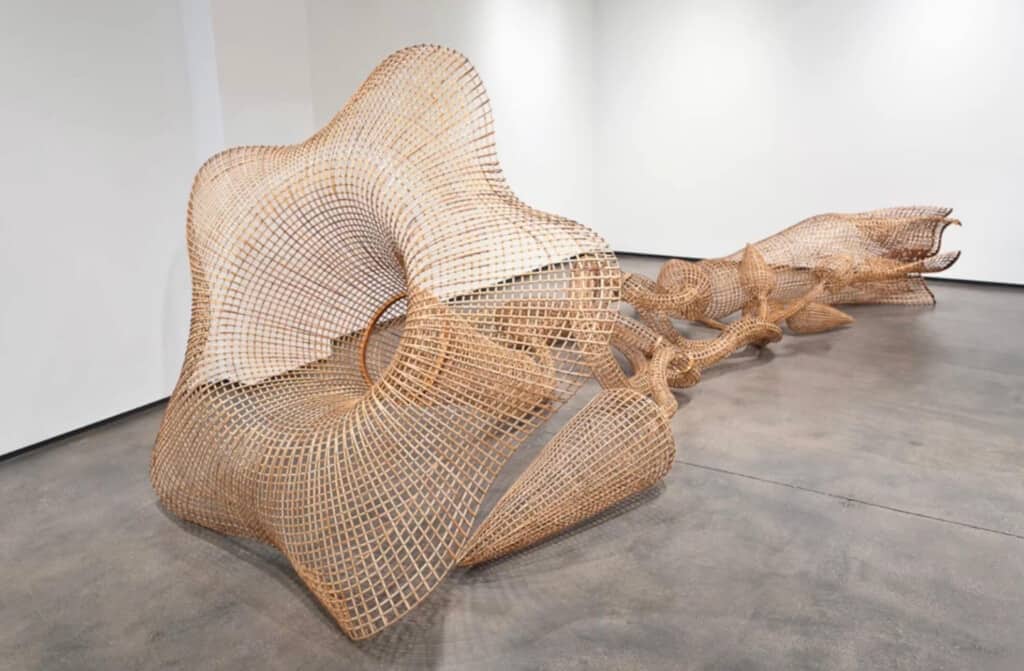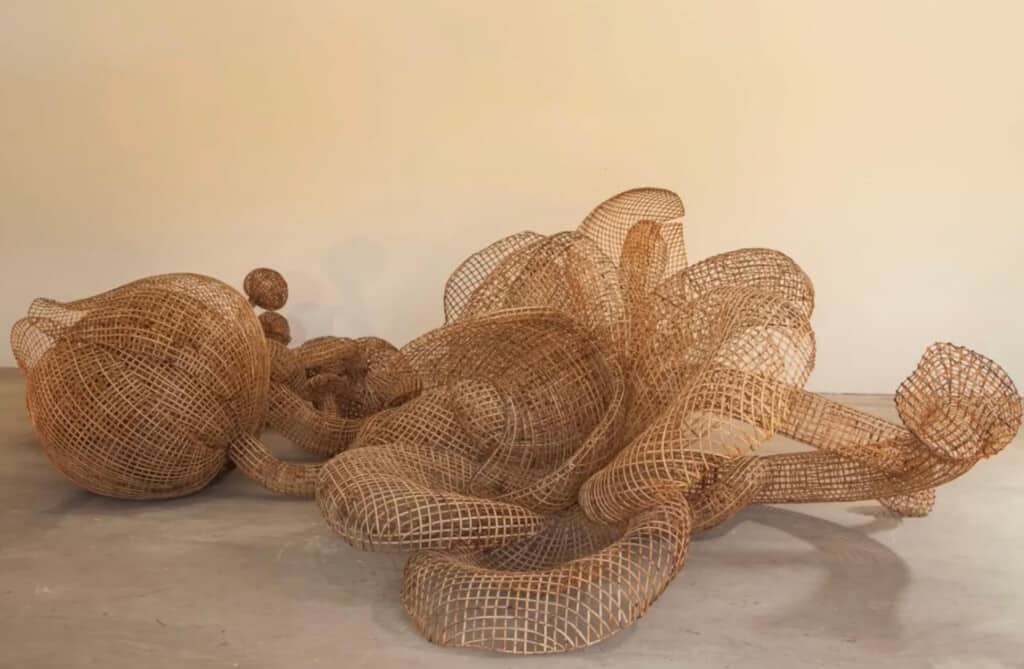Occasionally, you come across an artist living in a Third World country and producing truly world-class and noteworthy art. This is how I felt when I saw the natural materials-inspired artwork and sculptures of the Cambodian artist Sopheap Pich.
Sopheap Pich was born in Battambang, Cambodia. After the bloody Khmer Rouge regime in Cambodia ended, his parents immigrated to the United States. It was in the United States that he graduated with advanced art degrees. Upon returning to Cambodia, he started producing large oversized sculptures from readily available natural materials such as bamboo. Sopheap Pich’s art sculptures are theatrical pieces. Many are now on display in major museums around the world.
Table of Contents
- The Cambodian Artist Sopheap Pich’s Early Life in Cambodia
- Breaking Out of Cambodian Art School of Thought
- Frequently Asked Questions
- Related Content
Sopheap Pich is truly a world-class artist that is living and working in Phnom Penh, Cambodia. To discover more about Sopheap Pich and his artwork and techniques, you can watch the video produced by Bloomberg News.
The Cambodian Artist Sopheap Pich’s Early Life in Cambodia
Sopheap Pich was born in 1971 in Battambang, Cambodia, during the era of the Khmer Republic. He remembers helping his father fish and farm in his early Cambodian childhood memories.
In speaking of this period of his life in Cambodia, he said:
“I grew up as a young kid on a farm. My parents have always been farmers. Actually, I am the only one with a college degree.
Sopheap Pich – M Plus
I am used to making these things with my father, ie fish trap and catching frogs and snakes and stuff like that.”
Also seared into Sopheah’s young, impressionable mind was how each day when he was young, his father and on the way to go fishing would pass by a Buddhist Temple that had been turned into a place of execution by the bloody Cambodian Khmer Rouge regime. There was so much killing taking place in Cambodia during the Khmer Rouge that blood stained the temple walls and ceilings.
These memories undoubtedly made an impression on him and, later, his artwork. Some of his more famous images are those of Buddhas or Buddha’s heads, such as a Buddha’s head floating in the air with red paint at the bottom strands to symbolize the bloody era of the Khmer Rouge executions in the Cambodian Buddhist temples.

Sopheap Pich and his family lived through the Khmer Rouge era in Cambodia (1975 to 1979). They left Cambodia in 1979. First, they lived in a refugee camp in Thailand until immigrating to the United States in 1984.

Sopheap Pich’s Life in The United States
In 1984 at the age of 13, Sopheap finally enrolled in school in America. This was the first time in his life that he was in a formal classroom with other students and a teacher.
Upon graduating from High School, his father wanted him to become a doctor. But Sopheap had other plans. He graduated with a BFA in Art from the University of Massachusetts and later received an MFA also in aert at the Art Institute of Chicago.

Sopheap Pich – The Artist Returns To Cambodia
In 2002, Sopheap returned to Cambodia and started to create artistic sculptures using materials he could readily find available in Cambodia, such as rattan and bamboo. Many of the skills he learned to work with these natural materials were familiar to him from his early Cambodian childhood days when he helped his father make fish baskets for fishing.
In speaking of his choice of using natural material, Sopheap said this in an interview:
“I feel it’s the material that gives me a voice. Material is a kind of necessity, as an identification.”
Sopheap Pich – M PLus
Undoubtedly, his unique use of these readily available natural materials helps him stand out as an artist. Sopheap uses these materials in ways others have never thought to use them.

Breaking Out of Cambodian Art School of Thought
What is so unique about Sopheap is that he is not a typical Cambodian artist. He has broken the mold of how art is viewed in Cambodia and art education in Cambodia. He has shown the Cambodians that natural everyday materials like bamboo or rattan can produce amazing sculptures and works of art.
In speaking of how he has broken out the Cambodian art world, Sopheap said:
“The old rule of thumb in a Cambodian art school is ‘think before you do,’ I say well ‘Do before you think.” In art, you can actually do before you think. And that is the intuitive part – like playing.”
Sopheap Pich – M Plus
This is excellent advice for any artist. Listen to your inner voice and be creative while willing to break out of the mold. After all, it is an artist like Sopheap whose creativity helps change the world of art.

Also, in speaking of how he sees his art, Sopheap said this about his works of art:
I think I am a realist. My art is real. I am making real objects. There’s nothing abstract about it.
SOPHEAP PICH – M PLUS

Sopheap Pich is a Cambodian artist who should be on every art lover’s watchlist. He will continue to produce not only a lot of unique sculptures but also other artwork. He’s highly creative and unafraid to push his art’s limits in style, technique, and materials. I find his artwork incredibly inspiring to me as an artist.
Frequently Asked Questions
Who is Sopheap Pich?
Sopheap Pich is a Cambodian artist known for his remarkable sculptures and artworks inspired by natural materials, particularly bamboo. He was born in Battambang, Cambodia, and later pursued advanced art degrees in the United States.
What is Sopheap Pich known for?
Sopheap Pich is renowned for his oversized sculptures created from readily available natural materials like bamboo, rattan, and metal wire. His work is deeply inspired by his Cambodian heritage and often explores themes of memory, culture, and the human condition.
How did Sopheap Pich’s background influence his art?
Sopheap Pich’s upbringing in Cambodia during the Khmer Rouge regime and his subsequent move to the United States have greatly influenced his artistic perspective. His artworks often reflect his personal experiences and the socio-political context of his homeland.
What are some of Sopheap Pich’s notable works?
Some of Sopheap Pich’s notable sculptures include “Cycle,” “Compound,” “Morning Glory,” and “Rang Phnom Flower.” These works showcase his mastery of organic materials and his ability to transform them into intricate and thought-provoking pieces.
How does Sopheap Pich create his sculptures?
Sopheap Pich employs traditional Cambodian weaving techniques to create his sculptures. He meticulously weaves and constructs his pieces using materials like bamboo and rattan, often resulting in large-scale, immersive installations.
Where can I see Sopheap Pich’s art?
Sopheap Pich’s art has been displayed in major museums and galleries worldwide, including institutions such as the Metropolitan Museum of Art in New York, the Guggenheim Museum in Bilbao, and the Mori Art Museum in Tokyo.
What themes does Sopheap Pich’s art explore?
Sopheap Pich’s art often delves into themes of cultural identity, memory, displacement, and the relationship between nature and humanity. His sculptures evoke both a sense of familiarity and an otherworldly quality.
How does Sopheap Pich’s art contribute to contemporary art?
Sopheap Pich’s unique fusion of traditional Cambodian craft techniques with contemporary artistic expression has garnered international attention. His work bridges cultural heritage and modern art, offering a fresh perspective on both.
What impact has Sopheap Pich had on the art world?
Sopheap Pich has significantly expanded the global art community’s awareness of contemporary Cambodian art and craftsmanship. His innovative use of materials and his ability to create immersive environments have impacted the art world.
What is the significance of Sopheap Pich’s return to Cambodia?
Sopheap Pich’s decision to return to Cambodia after his education in the United States highlights his commitment to his roots and his desire to contribute to the revitalization of Cambodian arts and culture. His presence has inspired younger generations of artists in the country.
Anita Louise Art is dedicated to art education, great artists, and inspiring others to find and create their art. We love art that uplifts and inspires. #ArtToMakeYouSmile! #ArtToMakeYouHappy!
If you want to see any of my art, you can find out more by clicking here. If you are interested in what inspires me and my paintings, you can discover more by clicking here.
We have a free newsletter and would love you to be part of our community; you can subscribe to the newsletter by clicking here. If you have any questions, I would be happy to talk to you anytime. You can reach me, Anita, by clicking here.
Subscribe to our Anita Louise Art YouTube Channel with great videos and information by clicking here.
Related Content
Who Is the Japanese Woodblock Print Artist Utagawa Kuniyoshi (1798 – 1861)?
Utagawa Kuniyoshi was a Japanese artist, a ukiyo-e art style woodblock print master. His woodblock prints are artistic masterpieces. Kuniyoshi became an artist early in life, but success did not always come easy. He eventually became very popular as his artwork influenced the trends and fashions of his day.
You can discover more by reading our blog Who Is the Japanese Woodblock Print Artist Utagawa Kuniyoshi (1798 – 1861)? by clicking here.
Who Was the Chinese Painter 八大山人 Bada Shanren (1626-1705)?
Bada Shanren was born in 1626 as a Ming Dynasty Prince in Jiangxi Province, China. When the Ming Dynasty lost power, he hid for over 40 years at a Buddhist Monastery. When he left the monastery, he was in his 60s, and he became a professional artist. Bada Shanren made intense sounds and loud noises while he painted, so many people thought he was mad.
You can find out more about Bada Shanren by reading our blog Who Was the Chinese Painter 八大山人 Bada Shanren (1626-1705)? by clicking here.

